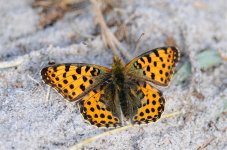A few years back there were at least 3 successive years where there were sightings of this species in the Minsmere area of Suffolk, suggesting some localised breeding + a prime spot for an immigrant.
Hello Aeshna5,
I'm aware of those records, and that's one of the things that disturbs me and makes me think that these specimens may have been 'seeded'.
There is very little evidence of this species breeding in Britain, and none for sucessful overwintering the this species in any stage.
Now, most of the records of the Q, of Sp. Frit are for
single specimens, as one would expect from a very rare migrant, and these are scattered from Cornwall all along the south coast and then north up the eastern coastline as far north as Lincs. A good number of the records are inland rather than being coastal.
Now, to have a rare species turn up on the same site, three years in succession, naturally, is stretching the bounds of credulity in my opinion.
Yes, Minsmere is a well attended RSPB site, the car parks are often overflowing. What better place to release specimens of captive bred Q of Spain Frits? There's a very good chance they will be seen, given the amount of naturalists present there for most of the year.
Now, maybe I'm wrong. I accept that, but I was trained as a detective in my younger days and I always look at suspicious records with more than a little scepitcism. I've always dealt in facts, rather than simply accepting what someone else has said.
Minsmere must be unique in having Q.of Spain Frits. present, three years in succession, with no evidence whatsoever of them being able to, or being seen to, overwinter in Britain.
Fritillaries are by no means difficult to breed, and sadly there are people out there that would like nothing more than to 'Con' other people into believing that rare migrant species are regular visitors to a particular site.
It's been done many times in the past, and no doubt will be done again in the future.
I've recorded and investigated local butterfly, moth and dragonfly records for over 50 years in my home counties of Northumberland and Durham. There are a fair number of dubious records, and some downright frauds, and the evidence is there to prove it, if your prepared to look for it.
The fact that someone records a rare migrant on any site is no guarantee
that the record is genuine. They may do in good faith, but unless some investigation is carried out, and good substansive evidence is obtained, I would tend to be sceptical to say the least.
It is interesting to note that a certain individual who is known to release captive bred specimens of many species lives less than 75 miles from Minsmere, a distance much shorter than he is prepared to drive to release other species he has captive bred.
I'm not trying to be just 'Bolshie' I'm only interested in the truth.
Harry.





